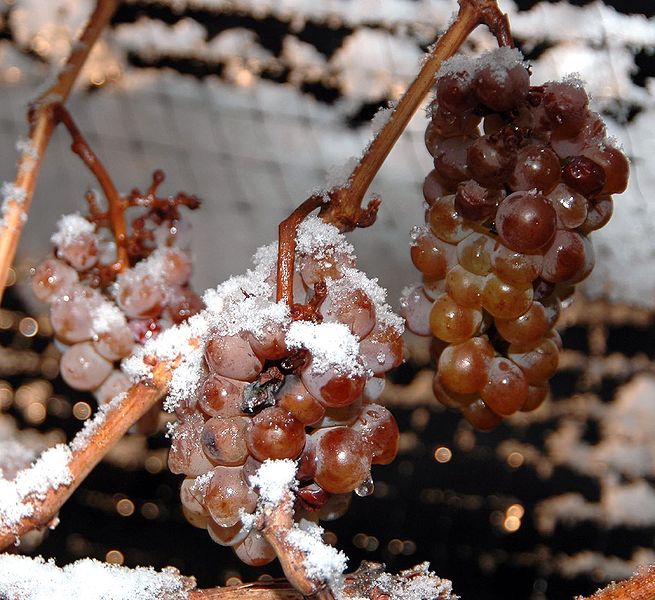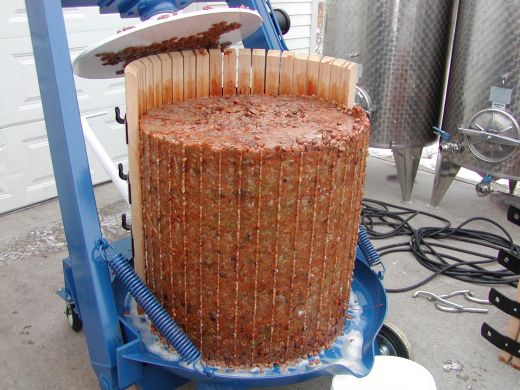Ice Wines....
 I adore dessert wines. I don't know where this love came from but as of late, I can't get my fill. Having gone through ports, muscats, and then lingering for a bit on a personal favorite of mine, Vin Santo Chianti Classico Reserva, I have now discovered ice wines. Though some of you wine conniseurs may be familiar with these wonderful dessert apertifs, more and more occasional wine enthusists are now discovering these exceptional wines.
I adore dessert wines. I don't know where this love came from but as of late, I can't get my fill. Having gone through ports, muscats, and then lingering for a bit on a personal favorite of mine, Vin Santo Chianti Classico Reserva, I have now discovered ice wines. Though some of you wine conniseurs may be familiar with these wonderful dessert apertifs, more and more occasional wine enthusists are now discovering these exceptional wines.
Ice wine, or Eiswein, originated in Franconia, Germany in 1794. Grapes were left on the vines until the first deep frost, and the freeze/thaw cycles that occurred concentrated both the sugars and flavors of the grapes. The process was refined, and now ice wines are highly prized  drinks that are created in Germany, Austria, and Canada. The Niagara region of Ontario, Canada is currently the most widely respected producer of ice wines in the world.
drinks that are created in Germany, Austria, and Canada. The Niagara region of Ontario, Canada is currently the most widely respected producer of ice wines in the world.
Ice wine is a type of dessert wine produced from grapes that have been frozen while still on the vine. The sugars and other dissolved solids do not freeze, but the water does, allowing a more concentrated grape must to be pressed from the frozen grapes, resulting in a smaller amount of more concentrated, very sweet wine. With ice wines, the freezing happens before the fermentation, not afterwards. Unlike the grapes from which other dessert wines, such as Sauternes, Tokaji, or Trockenbeerenauslese, are made, ice wine grapes should not be affected by Botrytis cinerea or noble rot, at least not to any great degree. Only healthy grapes keep in good shape until the opportunity arises for an ice wine harvest, which in extreme cases can occur after the New Year, on a northern hemisphere calendar. This gives ice wine its characteristic refreshing sweetness balanced by high acidity. When the grapes are free of Botrytis, they are said to come in "clean". Due to the labor-intense and risky production process resulting in relatively small amounts of wine, ice wines are generally quite expensive. This chart shows how sugar varies with the temperature: Temperature Sugar Content -6°C 29% -7°C 33% -8°C 36% -9°C 39% -10°C 43% -11°C 46% -12°C 49% -13°C 52% -14°C 56%
When the grapes are just right, they're carefully picked by hand. Grapes in this condition have a very low yield - often an entire vine only makes a single bottle. That's why ice wine can be so expensive and is often sold in half-bottles only ... but it's worth it!
Icewine is typically made of Vidal and Riesling grapes. After this long harvest process, the grapes go through weeks of fermentation, followed by a few months of barrel aging.
The wine ends up a golden color, or a deep, rich amber. It has a very sweet (of course) taste. The flavor is a combination of apricot, peach, mango, melon or other sweet fruits. There is often a nutty smell to it as well. It is usually drunk as a dessert wine, chilled for one or two hours. It is usually served in small cordial glasses.
Image Sources
edenwine.co.uk, longviewwinery.com, trentobike.org, spicetrader.net, Wolfgang Shultz, inniskillin, gvstudios.com, wineandpassionaccessories.com, lancette-arts.journal.ca, cookinglight.com, wikipedia.org







